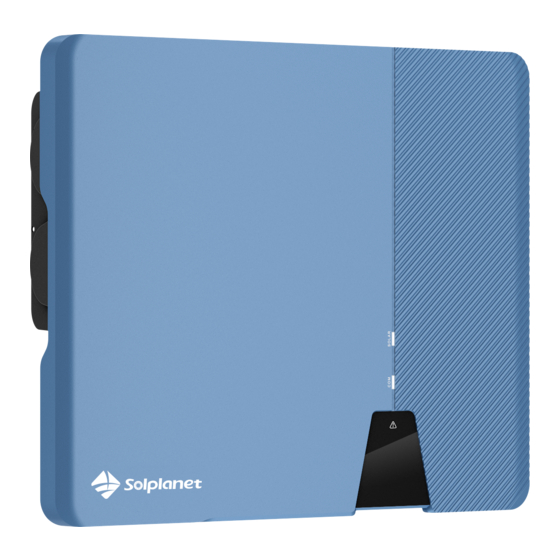
Table of Contents
Advertisement
Advertisement
Table of Contents

Summarization of Contents
1 Notes on this Manual
1.4 Symbols Used in this Manual
Explains the meaning of various safety and informational symbols used throughout the document.
2 Safety
2.1 Intended Use
Details the correct and intended applications for the inverter, including limitations and usage conditions.
2.2 Important Safety Information
Covers critical safety warnings related to electric shock, fire hazards, and proper component handling.
2.3 Symbols on the Label
Explains the specific safety, certification, and compliance symbols found on the inverter's physical label.
3 Unpacking
3.1 Scope of Delivery
Lists all components and accessories included in the inverter package for easy verification.
4 Mounting
4.1 Requirements for Mounting
Outlines necessary conditions, clearances, ventilation, and safety precautions for safe inverter installation.
4.2 Mounting the Inverter
Step-by-step instructions for physically attaching the inverter to the wall mounting bracket securely.
5 System Solution
5.2 System Wiring Diagram
Illustrates the electrical connections for the system, with specific diagrams for Australia and Europe.
5.3 Working Mode
Explains the different operational modes of the hybrid inverter, such as Self-Consumption and Backup.
6 Electrical Connection
6.1 Safety
Details critical safety precautions and warnings when performing electrical connections for the inverter.
6.4 AC Connection
Covers the procedure, cable requirements, and safety aspects for making the AC electrical connection.
6.7 DC Connection
Provides instructions and safety warnings for connecting the DC input from PV arrays to the inverter.
6.8 Battery Connection
Outlines the procedure, cable requirements, and safety precautions for connecting the battery system.
7 Communication
7.1 System Monitoring via WLAN
Explains how to monitor inverter status and performance using Wi-Fi integration and the AiHome mobile app.
7.2 Inverter Demand Response Modes (DRED)
Describes the inverter's demand response capabilities and the available command modes (DRM).
8 Commissioning
8.1 Electrical Checks
Lists essential electrical tests and verifications to perform before the initial startup of the inverter.
8.4 Start-Up
Details the procedure for safely powering on and starting the inverter after all checks and connections are complete.
9 Display
9.1 Overview of the Panel
Describes the physical layout of the inverter's front panel, including indicator lights and display elements.
9.1.1 LEDs
Explains the function, status (on, off, blink), and color of the various LED indicators on the inverter.
11 Technical Data
11.1 DC Input Data
Provides detailed specifications for the inverter's DC input parameters, including voltage and current limits.
11.3 AC Output Data
Details the technical specifications for the inverter's AC output, including power, voltage, and current ratings.
11.5 General Data
Lists general specifications such as dimensions, weight, operating temperature, installation, and communication interfaces.
11.6 Safety Regulations
Outlines the safety regulations, protection devices, and EMC standards that the inverter complies with.
11.7 Efficiency
Presents efficiency curves and maximum/MPPT efficiency data for the inverter under various conditions.
11.8 Power Reduction
Explains how and why the inverter automatically reduces its power output based on ambient temperature and grid conditions.
13 Maintenance
13.2 Cleaning the Heat Sink
Explains the process for cleaning the inverter's heat sink to maintain proper cooling and prevent overheating.
















Need help?
Do you have a question about the ASW3000H-S and is the answer not in the manual?
Questions and answers